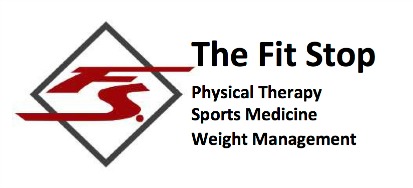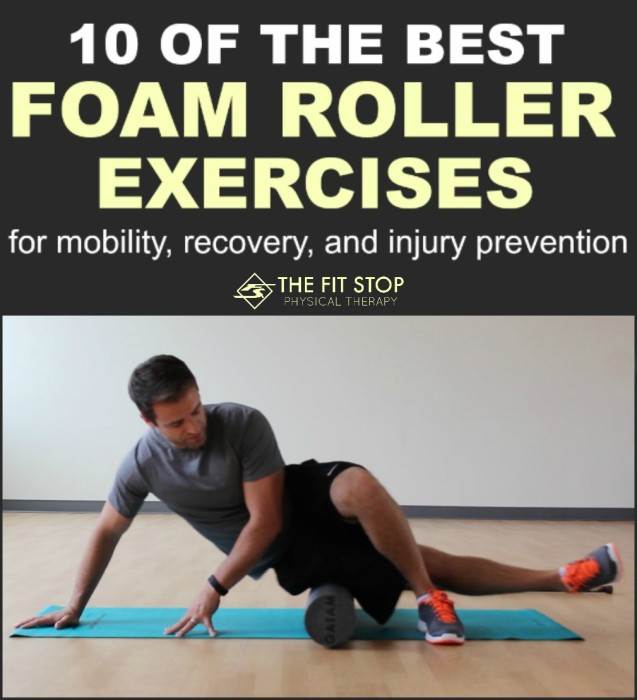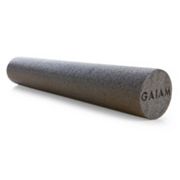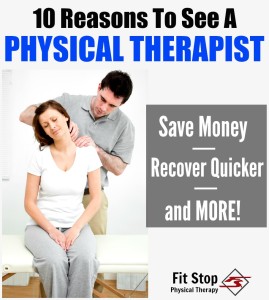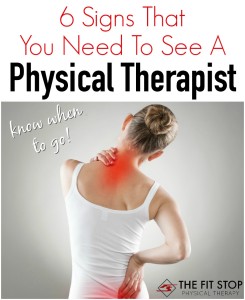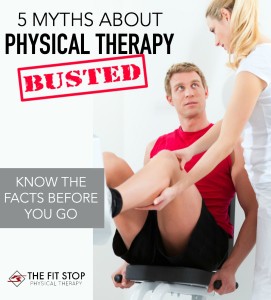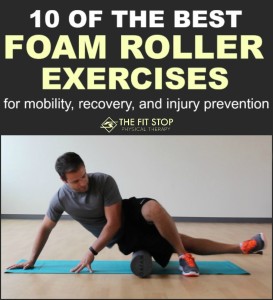10 of the Best Foam Roller Exercises
As a doctor of physical therapy, one of the simplest and yet most valuable pieces of equipment that we have in the clinic is the foam roller. This one simple tool offers numerous exercises with a myriad of benefits: increase joint flexibility, improve posture, injury prevention, and injury recovery (to name just a few!). Today on The Fit Stop Blog, I wanted to share with you my 10 favorite foam roller exercises to ascertain you enjoy a full summer of sun-filled, healthy, injury-free moving!
A foam roller is an incredibly simple piece of equipment. It’s literally a cylinder of hard foam; although now you can find them made of plastic, rubber, etc. They come in a wide variety of sizes: anywhere from 4″-8” in circumference and ranging from 12″-36” long. The one I prefer and that I personally recommend to my patients is 6” in diameter and 36” long (this is the one that I have in my house – my wife and I love it!). I prefer the longer length because I find them a little more versatile – you can do a little bit more with them without the fear of falling off the roller.
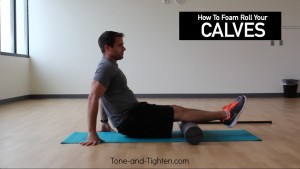 1. Calves – Sit with your legs extended out in front of you with the foam roller under your calves. Keeping your legs straight and using your arms and hands roll your calves up and down on top of the foam roller. Can be intensified by crossing the non-injured leg over the injured leg to put more pressure on the injured area as you roll it up and down.
1. Calves – Sit with your legs extended out in front of you with the foam roller under your calves. Keeping your legs straight and using your arms and hands roll your calves up and down on top of the foam roller. Can be intensified by crossing the non-injured leg over the injured leg to put more pressure on the injured area as you roll it up and down.
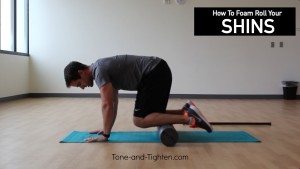 2. Shins – Kneel on all fours with the foam roller under your shins. Lift your knees off the ground and pull your knees up towards your hands and then push them back to the starting position.
2. Shins – Kneel on all fours with the foam roller under your shins. Lift your knees off the ground and pull your knees up towards your hands and then push them back to the starting position.
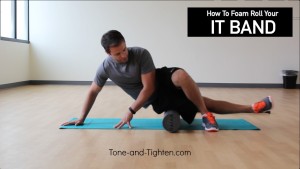 3. IT Band – Sit on top of the foam roller on your side with the affected/injured leg down on the foam roller. Cross your opposite leg in front with your foot flat on the floor; your hands are also brought in front and placed on the floor for stability. Use your hands and leg (the one on the ground) to roll the outside of your bottom leg up and down on the foam roller.
3. IT Band – Sit on top of the foam roller on your side with the affected/injured leg down on the foam roller. Cross your opposite leg in front with your foot flat on the floor; your hands are also brought in front and placed on the floor for stability. Use your hands and leg (the one on the ground) to roll the outside of your bottom leg up and down on the foam roller.
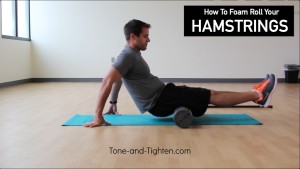 4. Hamstrings – Sit with your legs stretched out in front of you with the foam roller under your knees (same position as #1 – calves). Keep your legs straight and use your arms to roll your hamstrings on the foam roller from the back of your knee to the bottom of your butt. (You can target one specific hamstring by crossing the opposite leg over the top of the injured leg and performing the exercise as written).
4. Hamstrings – Sit with your legs stretched out in front of you with the foam roller under your knees (same position as #1 – calves). Keep your legs straight and use your arms to roll your hamstrings on the foam roller from the back of your knee to the bottom of your butt. (You can target one specific hamstring by crossing the opposite leg over the top of the injured leg and performing the exercise as written).
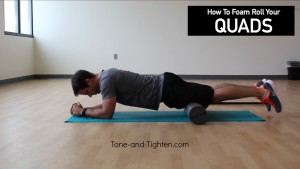 5. Quads – Lay face down in a forearm plank position with the foam roller under your quads. Use your arms/forearms to pull your body up and down with the foam roller traveling the length of your quad muscles from the front of your hips to the top of your knees.
5. Quads – Lay face down in a forearm plank position with the foam roller under your quads. Use your arms/forearms to pull your body up and down with the foam roller traveling the length of your quad muscles from the front of your hips to the top of your knees.
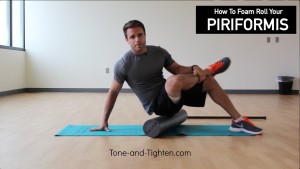 6. Piriformis – Sit on the foam roller. Cross your injured leg over your non-injured leg with your ankle just above your knee. Roll your body slightly to the injured side. Use your non-injured leg and both hands to roll your up and down your piriformis (one of the deep muscles of your hip – it’s deep to your gluteus maximus).
6. Piriformis – Sit on the foam roller. Cross your injured leg over your non-injured leg with your ankle just above your knee. Roll your body slightly to the injured side. Use your non-injured leg and both hands to roll your up and down your piriformis (one of the deep muscles of your hip – it’s deep to your gluteus maximus).
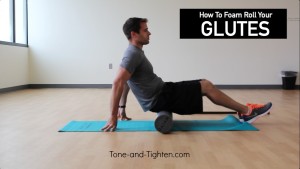 7. Glutes – Sit on the foam roller with your feet flat on the floor. Your hands are also down on the floor as you semi-recline backwards. Use your arms and legs to roll your butt up and down over the foam roller. Hint – you can emphasize one side or the other by leaning your body slightly to the injured side.
7. Glutes – Sit on the foam roller with your feet flat on the floor. Your hands are also down on the floor as you semi-recline backwards. Use your arms and legs to roll your butt up and down over the foam roller. Hint – you can emphasize one side or the other by leaning your body slightly to the injured side.
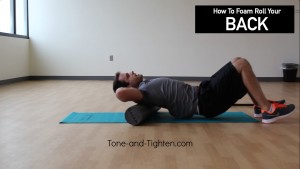 8. Spine (perpendicular) – Lay on you back with your knees bent, cradling your head in your hands, with the foam roller across your shoulder blades. Lift your hips up off the floor and use your legs to roll your body up and down on the foam roller. Try to relax your upper body and let your spine “fold” backwards over the foam roller to maximize stretching at each vertebrae
8. Spine (perpendicular) – Lay on you back with your knees bent, cradling your head in your hands, with the foam roller across your shoulder blades. Lift your hips up off the floor and use your legs to roll your body up and down on the foam roller. Try to relax your upper body and let your spine “fold” backwards over the foam roller to maximize stretching at each vertebrae
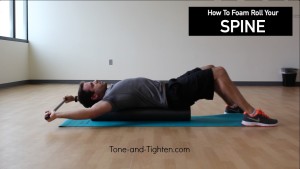 9. Spine (parallel) – Works best on a larger foam roller; I also prefer to do this one with a broom, mop, golf club, dowel, etc. With your knees bent and feet flat on the floor, lay on the foam roller (so it runs the length of your spine). Grab whatever rod you’re using and use it to stretch both hands high above your head and back towards the floor. Hold 10 seconds and return to starting position.
9. Spine (parallel) – Works best on a larger foam roller; I also prefer to do this one with a broom, mop, golf club, dowel, etc. With your knees bent and feet flat on the floor, lay on the foam roller (so it runs the length of your spine). Grab whatever rod you’re using and use it to stretch both hands high above your head and back towards the floor. Hold 10 seconds and return to starting position.
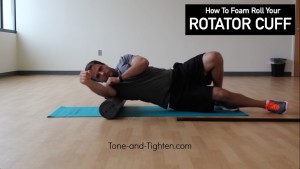 10. Rotator Cuff / Lats: Lay on your injured side on your foam roller with your arm extended either in front of you or up above your head. Lift your hips up off the floor and, using your legs, roll on top of the foam roller up and down. The foam roller should be right in the back of your arm pit / back of the shoulder / top of the latissmus dorsi area.
10. Rotator Cuff / Lats: Lay on your injured side on your foam roller with your arm extended either in front of you or up above your head. Lift your hips up off the floor and, using your legs, roll on top of the foam roller up and down. The foam roller should be right in the back of your arm pit / back of the shoulder / top of the latissmus dorsi area.
Looking for more great tips and advice from the physical therapists as Fit Stop? Here are some more of our recent blog posts:
Fit Stop Physical Therapy – Farmington
172 N East Promontory Ste 200
Farmington, UT 84025
(801) 558-8612
